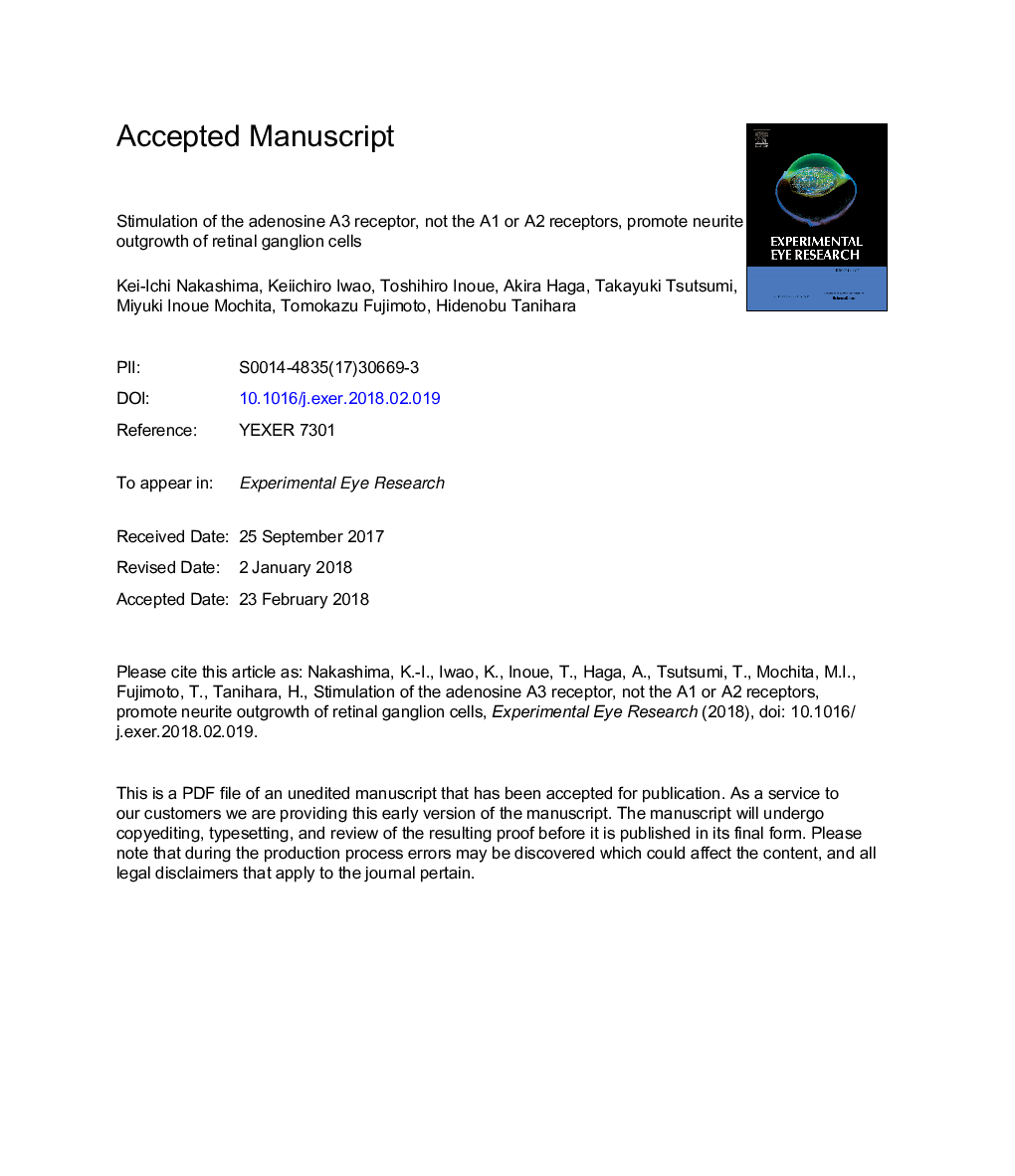| کد مقاله | کد نشریه | سال انتشار | مقاله انگلیسی | نسخه تمام متن |
|---|---|---|---|---|
| 8792016 | 1602552 | 2018 | 43 صفحه PDF | دانلود رایگان |
عنوان انگلیسی مقاله ISI
Stimulation of the adenosine A3 receptor, not the A1 or A2 receptors, promote neurite outgrowth of retinal ganglion cells
دانلود مقاله + سفارش ترجمه
دانلود مقاله ISI انگلیسی
رایگان برای ایرانیان
کلمات کلیدی
PI3KGSK3-βADORN6-cyclohexyladenosineNTGNeuroregenerationiOpRGCCNTFmTORBDNF - BDNF یا فاکتور نورونزایی مشتقشده از مغز cAMP - cAMPCyclic adenosine monophosphate - آدنوزین مونوفسفات Cyclicadenylyl cyclase - آدنیلات سیکلاز، آدنیلیل سیکلازAkt - آکتEnzyme-linked immunosorbent assay - تست الیزاELISA - تست الیزاretinal ganglion cell - سلول گانگلیونی شبکیهBrain-derived neurotrophic factor - فاکتور نوروتروفی مشتق شده از مغزciliary neurotrophic factor - فاکتور نوروتروفیک ciliaryphosphatase and tensin homolog - فسفاتاز و تنسین همولوگphosphoinositide 3-kinase - فسفینوزیتید 3-کینازIntraocular pressure - فشار داخل چشمCHA - نهmammalian target of rapamycin - هدف پستانداران رپامایسینPten - ژن PTENGlaucoma - گلوکوم normal tension glaucoma - گلوکوم تنش طبیعیGlycogen synthase kinase-3β - گلیکوزین سنتاز کیناز 3βAdenosine receptor - گیرنده آدنوزینAdenosine receptors - گیرنده های آدنوزین
موضوعات مرتبط
علوم زیستی و بیوفناوری
ایمنی شناسی و میکروب شناسی
ایمونولوژی و میکروب شناسی (عمومی)
پیش نمایش صفحه اول مقاله

چکیده انگلیسی
Among candidate neuroprotective agents, adenosine is thought to be a possible treatment for central nervous system disorders. Adenosine elicits biological effects through four G protein-coupled receptors (A1, A2A, A2B, and A3). The A2A and A2B receptors stimulate adenylyl cyclase (AC) and increase cyclic adenosine monophosphate (cAMP) levels, whereas A1 and A3 receptors inhibit AC and decrease cAMP levels. Several studies have investigated the effects of adenosine receptors (AdoRs) in glaucoma, because modulation of A1, A2A, or A3 receptor regulates intraocular pressure. In addition, AdoR-related phenomena may induce neuroprotective effects in retinal neurons. Notably, A1, A2A, and A3 receptor agonists reportedly inhibit retinal ganglion cell (RGC) death in in vitro and in vivo glaucoma models. However, there is limited knowledge of the effects of AdoR activation on neurite outgrowth or the regeneration of RGCs. In this report, we described the role of an AdoR subtype in neurite outgrowth and RGC axonal regeneration. The distribution of AdoRs in the retina was evaluated by immunohistochemical analysis. Using primary cultured rat RGCs in vitro and an optic nerve crush model in vivo, neurite elongation was evaluated after stimulation by the following AdoR agonists: CHA, an A1 receptor agonist; CGS21680, an A2A receptor agonist; BAY60-6583, an A2B receptor agonist; and 2-Cl-IB-MECA, an A3 receptor agonist. To determine the mechanism of neurite promotion, the candidate molecules of signal transduction associated with the neurite elongation of AdoRs were evaluated by enzyme-linked immunosorbent assay (ELISA) and Western blot analysis, respectively. All four AdoRs (A1, A2A, A2B, and A3) were present in the inner retinal layers. Among the agonists for AdoR, only 2-Cl-IB-MECA significantly promoted neurite outgrowth in primary cultured RGCs. Signaling pathway analyses showed that 2-Cl-IB-MECA caused upregulated phosphorylation of Akt in cultured RGCs. Additionally, LY294002, an inhibitor of Akt, suppressed the neurite-promoting effects of the A3 receptor agonist in RGCs. Moreover, 2-Cl-IB-MECA increased the number of regenerating axons in the optic nerve crush model. Taken together, these data indicate that activation of the A3 receptor, not the A1 or A2 receptors, promotes in vitro and in vivo neurite outgrowth during the regeneration of rat RGCs, which is caused by the activation of an Akt-dependent signaling pathway. Therefore, AdoR activation may be a promising candidate for the development of novel regenerative modalities for glaucoma and other optic neuropathies.
ناشر
Database: Elsevier - ScienceDirect (ساینس دایرکت)
Journal: Experimental Eye Research - Volume 170, May 2018, Pages 160-168
Journal: Experimental Eye Research - Volume 170, May 2018, Pages 160-168
نویسندگان
Kei-Ichi Nakashima, Keiichiro Iwao, Toshihiro Inoue, Akira Haga, Takayuki Tsutsumi, Miyuki Inoue Mochita, Tomokazu Fujimoto, Hidenobu Tanihara,